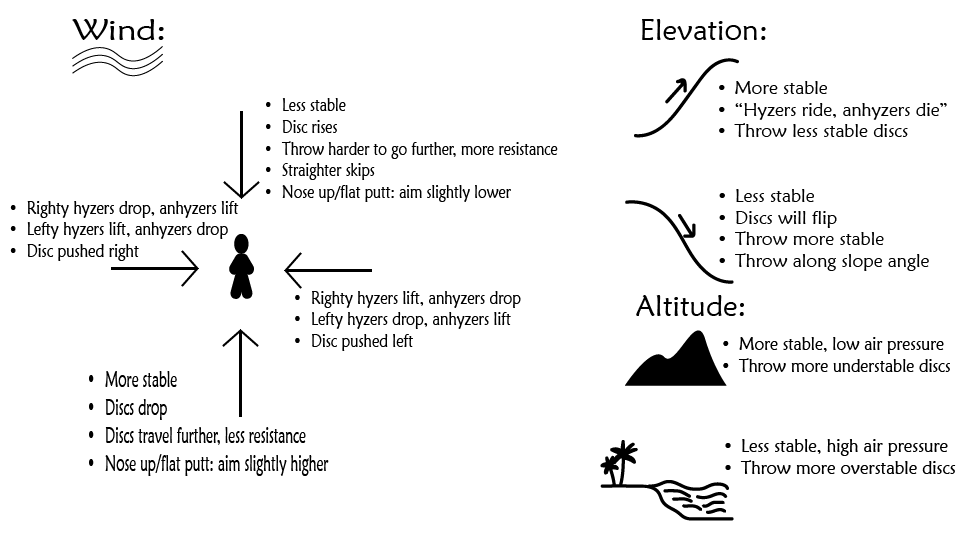
How does elevation, altitude, or wind affect the flight of a disc?
If you've been playing disc golf for any period of time you know that your discs can do some pretty crazy things if there is any wind or elevation in play. Here's what to expect when you encounter wind, elevation, or altitude changes! Don’t worry at the end I’ll have a little recap to make things easier for you to screenshot and save to your phone for easy access during rounds!
Wind
Wind is something that you will experience just about every time you go out to play disc golf. Meaning it is super important to know how your discs are going to react with different wind directions and speeds. I would recommend going out to a field with your full bag when it’s windy to see how your individual discs fly in the wind. This will help you gain confidence in these situations and will help your scores overall during a windy round. After all, confidence is the key to playing a successful round of disc golf!
Now to get into the real reason you clicked on this article: to see how wind directions affect the flight of your disc.
Headwind:
First of all, a headwind means the wind is blowing directly towards your face. In disc golf a headwind causes your discs to act more understable. For a righty backhand throw this means your disc will start to go to the right. The discs act like they are understable because the wind is pushing against your disc. This also means you need to force your disc to carry further by throwing them harder because the wind will try to slow your disc down. Due to the wind moving in the opposite direction of your disc, it can also cause your disc to rise up, or bounce up, in the air. Therefore, it is usually best to throw lower in a headwind to help stop your disc from rising up to a height where it could stall out and be pushed backwards by the wind. Also when your disc lands, the headwind can cause them to have straighter skips than they might normally have. When you are putting into a headwind and have a flat to nose up putt, you should aim slightly lower than normal because the headwind will lift your disc up. Also if it is very windy out a spin putt would be the best option. Putts that do not have a lot of spin, like a normal push putt, will be jostled around a lot more than those with more spin on them. The spin will help the disc cut through the wind.
Tailwind:
A tailwind means the wind is blowing in the same direction as you are facing, coming from behind you. Tailwinds cause your discs to act more stable than normal. The wind in a tailwind pushes your disc in the same direction as your throw, meaning you are going to throw a little further with your disc since the wind is helping push it in the right direction. However, a tailwind can also cause your disc to drop down, from the wind pushing it down. When putting with a flat to nose up putt you should aim slightly higher than normal because the wind will push your disc down. It will also help carry your disc to the basket, so you don’t need as much force on longer putts. Push putts are not as affected by tailwinds as they are with headwinds, however it is still best to put some more spin on your disc to mitigate the effect the wind has.
Right to Left Crosswind:
Crosswinds are different compared to head and tailwinds and mostly affect your disc based on the angle you put it on. However this information is also good to keep in mind and used with the previous information if you have a right to left headwind for example. A right to left wind will cause your disc to be pushed to the left. So, you might want to aim further right than you would normally so you can land in the middle of the fairway with the extra push the wind will provide. In a right to left wind, right handed players will experience their hyzers lift and their anhyzers drop. Left handed players will find that their anhyzers lift and their hyzers drop. In all crosswinds my tip would be to try and throw low and flat to minimize the effect the wind has on the disc and help prevent them from turning into rollers.
Left to Right Crosswind:
A left to right crosswind will cause your disc to be pushed to the right. Therefore, you might want to aim further left to land in your intended landing zone. Right handed players will have their hyzers drop and their anhzyers lift. Left handed players will have their hyzers lift and their anhyzers drop. Again, throwing low and flat will minimize the damage the wind has on your disc.
Elevation:
The elevation of a course can vary. Sometimes you don’t have to worry about throwing up or down hill, but it is important to know just in case you do play somewhere with a lot of elevation changes.
Uphill:
When you throw uphill, your discs will act more overstable than they normally do. One saying that is good to remember when throwing uphill is that “hyzers ride, and anhzyers die”. Meaning a hyzer going up hill is going to ride up the hill and an anhyzer is usually going to burn out and not get over the top of the hill. Another tip for throwing uphill is to aim wider than you want to help combat the overstability of the disc. Throwing an understable disc will also help combat the overstability of going uphill.
Downhill:
When you throw downhill, your discs will be more understable than usual. Throwing your disc on a hyzer and/or throwing a slightly overstable disc will be best because this will cause your disc to flip up to flat instead of completely turning over. It also helps to throw along the angle of the slope for both uphill and downhill throws. This minimizes the effect the hill, and air under the disc, have on the disc.
Altitude:
This is something to keep in mind if you are traveling and planning on playing in a different region than you are used to. The altitude refers to your location in relation to sea level. So, high altitude means you are higher up from sea level. Think playing in the mountains. Low altitude means you are closer to sea level. Think playing by the coast.
High Altitude:
At a high altitude, discs are more overstable due to the low air pressure. This means that for a righty back hand throw your disc is more likely going to drift left sooner than normal and it will be harder to turn your disc over. Therefore you should probably throw more understable discs to help combat the natural overstability of your surroundings.
Low Altitude:
At a low altitude, discs are less stable due to the high air pressure. For a righty backhand throw this means your disc will start wanting to drift right sooner. Therefore, it is recommended that you throw more stable discs to stop your discs from turning over.
Recap:
Now that we have gone over how wind, elevation, and altitude affect discs, here is a quick chart to help you remember!
-Jen ♡
